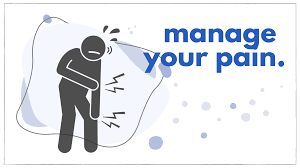Managing Pain: Strategies for a Healthier Life
Pain is a universal experience that can significantly impact our daily lives and overall well-being. Whether it’s acute or chronic, physical or emotional, managing pain effectively is essential for maintaining a good quality of life. Here are some strategies to help you better manage and cope with pain:
Understand the Source of Pain
The first step in managing pain is to understand its source. Whether it’s due to an injury, medical condition, or emotional distress, identifying the root cause can help you determine the most appropriate treatment and coping mechanisms.
Consult with Healthcare Professionals
Seeking guidance from healthcare professionals such as doctors, physical therapists, or mental health specialists can provide you with valuable insights and treatment options for managing your pain effectively. They can help create a personalized plan tailored to your specific needs.
Explore Non-Pharmacological Treatments
In addition to medication, consider non-pharmacological treatments such as physical therapy, acupuncture, massage therapy, yoga, or meditation. These alternative therapies can complement traditional medical treatments and provide additional relief from pain.
Practice Mindfulness and Relaxation Techniques
Mindfulness practices like deep breathing exercises, progressive muscle relaxation, guided imagery, and meditation can help reduce stress levels and improve your ability to cope with pain. By focusing on the present moment and cultivating a sense of calmness, you may experience a decrease in pain perception.
Stay Active and Maintain a Healthy Lifestyle
Regular physical activity not only helps improve your overall health but also plays a crucial role in managing pain. Engage in low-impact exercises like walking, swimming, or cycling to strengthen your muscles and joints while reducing stiffness and discomfort. Additionally, maintaining a balanced diet and staying hydrated can support your body’s natural healing processes.
Build a Support System
Don’t underestimate the power of social support in managing pain. Surround yourself with understanding family members, friends, or support groups who can offer encouragement, empathy, and practical assistance during challenging times. Sharing your experiences with others can alleviate feelings of isolation and provide emotional relief.
In conclusion, managing pain requires a comprehensive approach that addresses both the physical and emotional aspects of discomfort. By incorporating these strategies into your daily routine, you can take control of your pain management journey – empowering yourself to lead a healthier, more fulfilling life.
Top 6 Frequently Asked Questions About Pain Management
- How do you manage pain?
- What are some pain coping strategies?
- What are the 3 P’s of pain management?
- What are the four types of pain?
- How to deal with severe chronic pain?
- What are the 4 A’s of pain management?
How do you manage pain?
Managing pain involves a multifaceted approach that combines understanding the source of pain, consulting with healthcare professionals, exploring non-pharmacological treatments, practicing mindfulness and relaxation techniques, staying active, maintaining a healthy lifestyle, and building a strong support system. By addressing both the physical and emotional aspects of pain, individuals can develop personalized strategies to effectively cope with and alleviate discomfort. It’s essential to create a comprehensive pain management plan that considers individual needs and preferences to promote overall well-being and quality of life.
What are some pain coping strategies?
When it comes to managing pain, there are various coping strategies that can help individuals navigate their discomfort effectively. Some common pain coping strategies include mindfulness techniques such as deep breathing and meditation, physical activities like gentle stretching or yoga, seeking support from healthcare professionals for tailored treatment plans, engaging in relaxation practices to reduce stress levels, and maintaining a healthy lifestyle through proper nutrition and hydration. By incorporating a combination of these strategies into daily routines, individuals can develop a personalized approach to pain management that addresses both the physical and emotional aspects of their discomfort.
What are the 3 P’s of pain management?
The 3 P’s of pain management refer to a comprehensive approach that involves understanding and addressing the physical, psychological, and pharmacological aspects of pain. Physical strategies focus on treating the underlying cause of pain through interventions such as medication, physical therapy, or surgery. Psychological approaches aim to manage the emotional and cognitive aspects of pain through techniques like relaxation, mindfulness, and cognitive-behavioral therapy. Pharmacological methods involve the use of medications to alleviate pain and improve quality of life. By considering and integrating these three components into a holistic pain management plan, individuals can effectively address their pain symptoms and enhance their overall well-being.
What are the four types of pain?
Pain can manifest in various forms, classified into four main types: acute pain, chronic pain, nociceptive pain, and neuropathic pain. Acute pain is typically short-lived and serves as a warning signal of injury or illness. Chronic pain persists over an extended period and can have a significant impact on daily life. Nociceptive pain arises from tissue damage or inflammation, while neuropathic pain results from nerve dysfunction or damage. Understanding the different types of pain is crucial in developing tailored treatment plans for effective pain management.
How to deal with severe chronic pain?
Dealing with severe chronic pain can be a challenging and overwhelming experience for many individuals. It is essential to approach the management of severe chronic pain with a comprehensive and personalized strategy. Consulting with healthcare professionals, such as pain specialists or physical therapists, can help develop a tailored treatment plan that may include a combination of medication, physical therapy, psychological counseling, and alternative therapies like acupuncture or mindfulness practices. Building a strong support system of family and friends who understand your condition can also provide emotional comfort and practical assistance in coping with the daily challenges of living with severe chronic pain. Remember that managing severe chronic pain is a journey that requires patience, resilience, and a proactive approach to improving your quality of life.
What are the 4 A’s of pain management?
The 4 A’s of pain management are an essential framework that healthcare professionals use to address and treat pain effectively. These include Analgesia (relief from pain), Activities of Daily Living (maintaining functionality), Adverse Effects (monitoring and managing side effects of treatment), and Aberrant Drug-Related Behaviors (identifying and addressing any misuse or problematic behaviors related to pain medication). By focusing on these key aspects, healthcare providers can develop comprehensive pain management plans tailored to each individual’s needs, promoting better outcomes and improved quality of life for patients experiencing pain.



